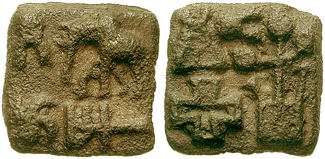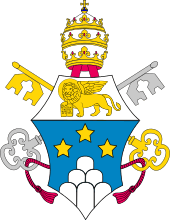Arched-hill symbol
The Arched-hill symbol is a symbol on ancient Coinage of India. There are some variations to the number of the hills depicted, or the symbol surmounting the hill, such as a crescent or a star.

It is thought that the three-arched hill symbol was initiated during the Maurya Empire (3rd–2nd century BCE).[1] Later, in coins from Taxila dated from 220 BCE, the three-arched symbol appears regularly, and from 185 BCE is regularly associated with the animal figures of the elephant and the lion.[2] In contrast, the Nandipada is generally associated with the zebu bull.[3] On coins of the Shunga period, the three-arched hill can appear among a multitude of other symbols, such as the Nandipada, the tree-in-railing, the elephant, or the empty cross.
The symbol is generally considered a representation of a Buddhist Chaitya or a Meru.[4][5] It has also been argued that it was the imperial symbol of the Mauryas.[6] The symbol however, appears in many post-Mauryan contexts as seen with the coins of Taxila and the Shungas.
Gallery
 A Sunga coin (150 BCE-100 CE) with three-arched hill (reverse, top left) among other symbols.
A Sunga coin (150 BCE-100 CE) with three-arched hill (reverse, top left) among other symbols.- An Arched-hill symbol on the reverse of this Maurya Empire coin.
._Circa_220-185_BC_Column_and_Hill.jpg) Single-die local coinage of Taxila. Column and arched-hill symbol (220-185 BCE).
Single-die local coinage of Taxila. Column and arched-hill symbol (220-185 BCE). Taxila coin (Post-Maurya, 185-160 BCE).
Taxila coin (Post-Maurya, 185-160 BCE). A six-arched hill symbol with star on top, with tree-in-railing on a coin of Indo-Greek king Agathocles.
A six-arched hill symbol with star on top, with tree-in-railing on a coin of Indo-Greek king Agathocles. A six-arched hill symbol on Pope John Paul I coat of arms. Fairly common in other coats of arms in Italy.
A six-arched hill symbol on Pope John Paul I coat of arms. Fairly common in other coats of arms in Italy.
See also
References
- "The crescented three- arched hill symbol, seems to have originally been adopted by Chandragupta Maurya." Malwa Through the Ages, from the Earliest Times to 1305 A.D, Kailash Chand Jain Motilal Banarsidass Publ., 1972
- CNG Coins
- CNG Coins
- "symbols generally called as three- or six- or multiple-arched hill or chaitya" Tribal Coins of Ancient India - Devendra Handa - 2007 Page 197
- "Let us examine the symbol of Hillocks. The three arched hill symbols called variously as Meru, Chaitya etc. with its several variations, for example with five arches," six arches, » three arches of which one is placed above the two..." Seminar Papers on the Local Coins of Northern India, Awadh K Narain - 1968, p.193
- Coin Splendour: A Journey Into the Past, Prasanna Rao Bandela, Abhinav Publications, 2003, p.28